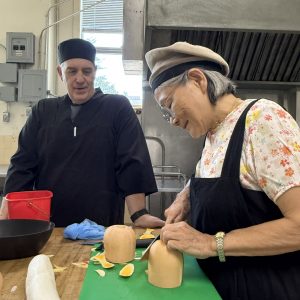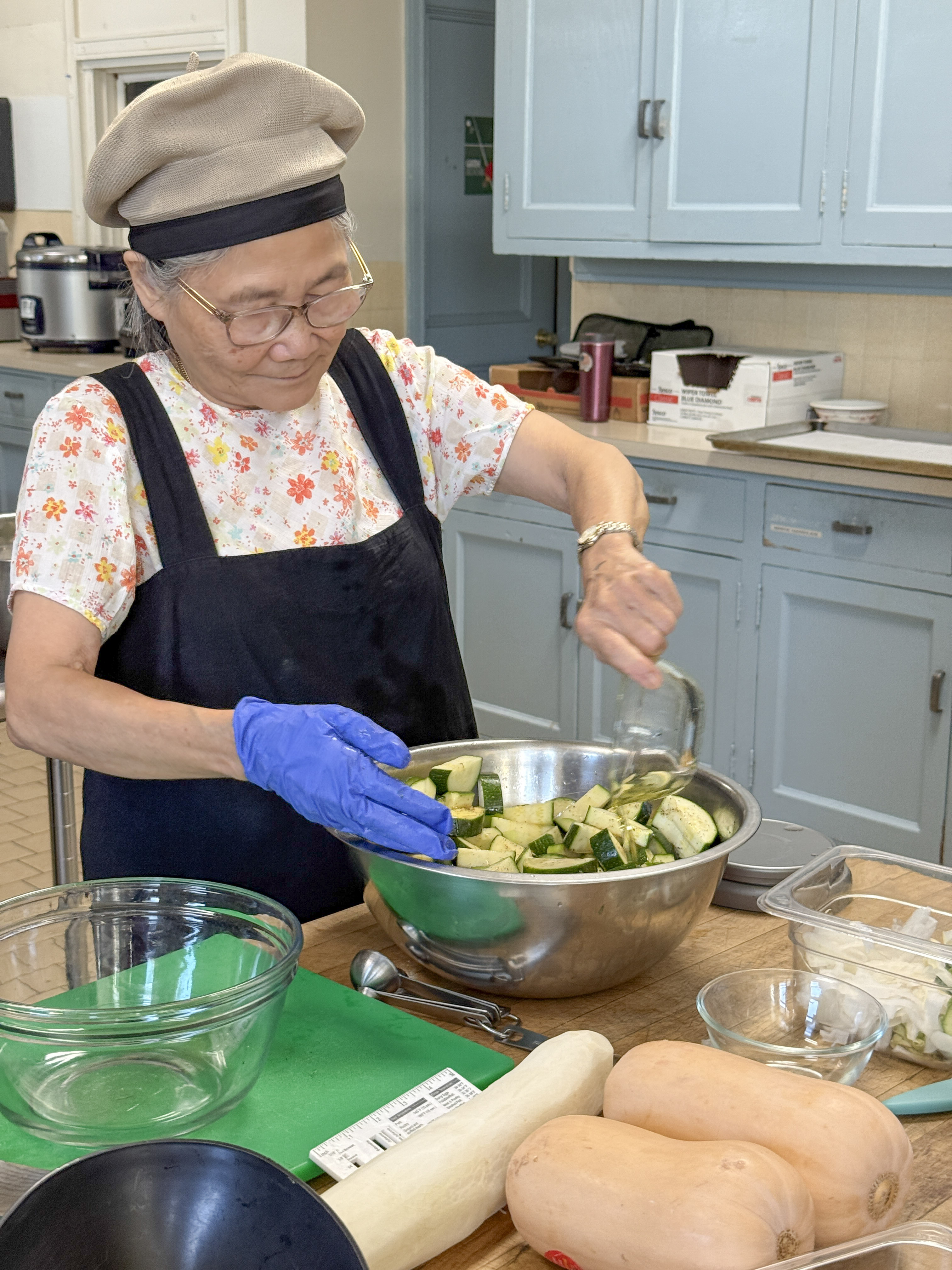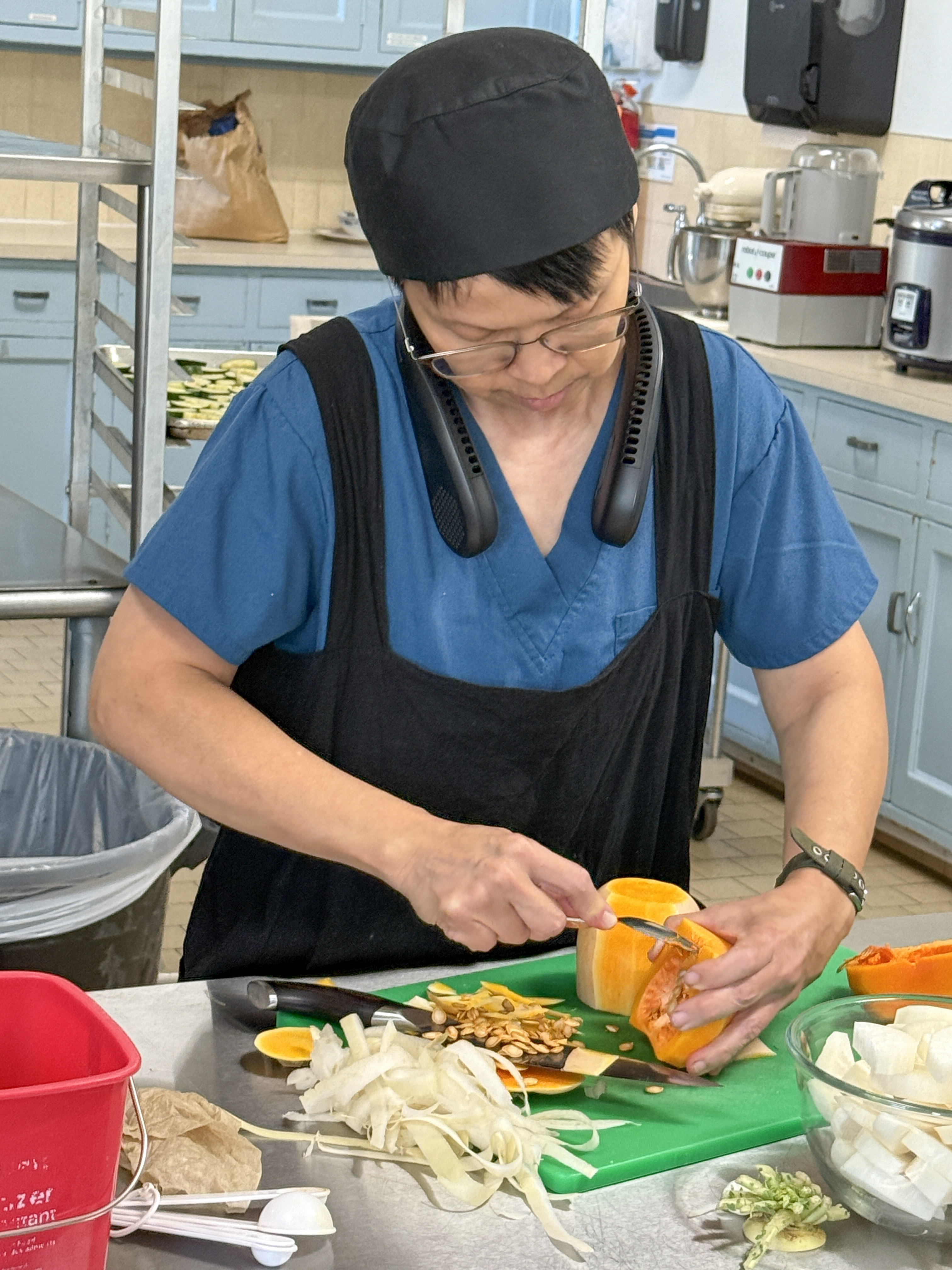
Cultivating in the Kitchen
More Reflections from Our Culinary Certificate Program
Last month we published a reflection from Amy Li, one of the students in our new Shojin Culinary Arts Certificate Program. This month we talked to Leonie Tan and Amanda Setera, the program’s other two students.
Leonie Tan
 Why did you want to join the program?
Why did you want to join the program?
Leonie: It was an opportunity I couldn’t miss because I had wanted to learn under a chef when I was young, but I didn’t have the chance because the opportunity and timing were not right. Plus, there wasn’t one that was fully vegetarian. So I just jumped in.
We learn a lot here because it’s very systematic. The chef is teaching us safety, knife skills, and measurement, which is very important. That way it’s not just estimate everything. We have to weigh it.
Have you cooked any specific recipes or you’re mostly doing preps so far?
We cook recipes. At first was a lot of prep and follow along, and then after that, we do a meal by ourselves. We have the recipe. We always look at a recipe. Then we gain some confidence. Now we kind of memorize, automatically memorize some of those things, like, how many ounces, how many tablespoons, teaspoons? So we become quite natural in that. Then we even cook a meal. We have a trial meal. That means the entree until the end. I had first practice and second practice, so I’ll be doing a third practice after that. Then I think I’ll be more confident to be preparing a dinner for twenty or thirty students.
What was one of the meals that you cooked? What were the different dishes?
So far, we learned a lot of things: baking vegetables, how to steam rice in the oven, which is very interesting, and then also how to make sauces. Something I really love is Bolognese, because I cook a lot of spaghetti, but I don’t know how to make Bolognese. We got to do the Italian Bolognese the right way. That’s the red sauce. And Chef Squire is also teaching the white sauce. So I’ll be learning two kinds. So far I’m very happy because I can kind of perfect my spaghetti the correct way, instead of my own way, just to feed my own children. Now it’s like the more official way, so I’m very happy.
After that, I can practice another thing: steaming rice in the oven, which is very nice. And then we’ll learn how to cook curry.
We’re really learn everything: sauteing, baking, marinating, and other things. We also learn how to make dessert. We are progressing into many things.
Bolognese sauce usually has meat in it. So what did you put in it instead?
I never knew that, actually, we can put in TVP (textured vegetable protein). I didn’t even know how to cook TVP. It’s very nice, very crispy.
What about the cultivation aspect? Has this affected your cultivation in any way?
To be able to be in this kitchen, I think we need to have a kind of joyful mind. We have to be happy to be here. That’s one thing. Another thing is, our intention is to give people good food that’s nurturing. That means a balanced diet. That’s very important. Another mind is a mind that is magnanimous. So we don’t discriminate. We just want to have that kind of field, that state of mind, and put our state of mind into the food so that the food will be well done. So I would say there is a lot of cultivation in that. Like a meditation in a sense. We always meditate before we start cooking, so that carries to the kitchen.
For me, it’s a lot of cultivation in this kitchen. It’s like at home, if a mother is cooking for their children, for their whole family—but then it’s family. Now carry that over. It’s for so many students. For faculty and staff who like to come here to have food. I think that part of cultivation is very important to me. I said at the start that I wanted to learn when I was young. I was very influenced by the Venerable Master, because he was teaching about food, and at the time I thought, How nice, I could have this kind of place like 7-Eleven on every corner where people could get food easily without having to harm animals. Plant-based. But I couldn’t study at that time because it wasn’t the right time, the right place to meet a chance to learn more about it and to be more confident.
Actually the plant-based kitchen—it’s not like fake meat. It’s not that from this kitchen. TVP is a textured soybean product. It’s not a meat replacement. It’s protein, and it tastes good. Nothing’s fake. It’s just plant-based. So now I’m more confident. We have Chef Squire, and he’s put in a lot of effort to help us with meals: the starch, the protein, all kinds of color. And then something very important he has been talking about is blanching. How to blanch and shock the vegetables to prevent carry-over cooking. These are some of the skills we might have been doing, but we didn’t have a formal lesson. So this is really good for me, I think. And for everyone. That is, if everybody can have that interest coming in. But I have super interest in this whole thing, so I feel that I benefited a lot. In my mind I’m already planning out something. I hope it will materialize this time. Last time it couldn’t, but this time I hope so. We can make a lot of contributions, give a lot back with this plant-based kitchen.
Amanda Setera
 Why did you want to join the program?
Why did you want to join the program?
Amanda: This program is one of a kind. I don’t think in the market right now there’s such a program where you can cook vegetarian with no eggs, no garlic, onion, or other pungent plants.
Is cooking something that you already knew how to do, but this is adding on?
I know how to cook Chinese cuisine, but not others, like American cuisine, Mexican cuisine. I haven’t had the opportunity to taste the food at restaurants because they have pungent plants. So the program was interesting and I wanted to learn more, since my husband is American. He was so happy to be able to eat chili, burritos, beans without garlic and onion.
What about the philosophy behind the program, and the and the cultivation part of it?
You have to be really mindful and put lots of love into the cooking. The colors really represent, I believe, that when we’re able to learn this technique, preparing all this either vegan food or eggless food without pungent plants, it’s to serve the community, our community, delicious food and seeing the joy. It brings inner happiness in me. The spiritual part? That’s also part of part of why I signed up for this program. Because it’s combined with spiritual practice. So I can just treat the kitchen as a Buddha hall. Meditation just to look within instead of looking out outward. So I highly recommended it to whose who really want to learn more, because really, you can’t find any cooking program out there with no meat, no eggs, no pungent plants, this kind of thing.
Could you tell us one of the meals you prepared?
I love to do fried rice. Tofu egg fried rice. That’s my favorite. And eggplant. More of Chinese style of cooking dishes. For the rice, you use tofu instead of egg, and nutritional yeast. Since I was young, I loved egg fried rice. I just missed that one since I’ve been holding precepts. I watch a lot of YouTube, and because I love it, I learned how to do it from scratch. And from here, I’ve learned how to make bigger portions to share with everyone. At home I just cook for three people. That’s a lot easier. For this, time management is very important. Time to prepare.
Squire, the chef, teaches us that you need starch, protein, green veggies, soup, something like that, so it’s a very balanced meal for everybody. That’s very important. From him I also learned how to steam rice in the oven. We usually use the rice cooker. That’s a surprise to me. I only bake my dessert, like cake. Baking is my first priority. Next semester he’s going to teach us that. I’ve been doing baking since I was a caregiver for the elderly nuns. I learned how to bake because I love cake.